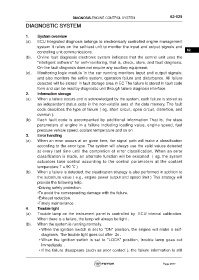Page 2577 - Foton Workshop Manual - Sauvana
P. 2577
DIAGNOSIS-ENGINE CONTROL SYSTEM 62-525
DIAGNOSTIC SYSTEM
1. System overview
(a). ECU integrated diagnosis belongs to electronically controlled engine management
system It relies on the self-test unit to monitor the input and output signals and
controlling unit communications. 62
(b). Online fault diagnosis electronic system indicates that the control unit uses the
"intelligent software" for self-monitoring, that is, check, store, and fault diagnosis.
On-line fault diagnosis does not require any auxiliary equipment.
(c). Monitoring logic module in the car running monitors input and output signals;
and also monitors the entire system, operation failure and disturbance. All failure
detected will be stored in fault storage area in EC The failure is stored in fault code
form and can be read by diagnostic unit through failure diagnosis interface.
2. Information storage
(a). When a failure occurs and is acknowledged by the system, each failure is stored as
an independent status code in the non-volatile area of the data memory. The fault
code describes the type of failure ( eg. short circuit, open circuit, distortion, and
overrun ).
(b). Each fault code is accompanied by additional information That is, the state
parameters of engine in a failure including loading value, engine speed, fuel
pressure vehicle speed, coolant temperature and so on.
3. Error handling
(a). When an error occurs at an given time, the signal path will make a classification
according to the error type. The system will always use the valid values detected
at every last time until the completion of error classification. When an error
classification is made, an alternate function will be executed ( eg, the system
actuators take control according to the control parameters at the coolant
temperature T = 90 ℃ )
(b). When a failure is detected, the claudication strategy is also performed in addition to
the substitute value ( e.g., engine power output and speed limit ) This strategy will
provide the following help.
•Driving safety protection.
•To avoid the corresponding damage with the failure.
•Exhaust reduction.
•Timely maintenance .
4. Trouble light
(a). Trouble lamp on the instrument panel is controlled by ECU internal calibration.
When there is a failure, the lamp will always be light .
(b). When the system is running normally.
• When the ignition switch is set to "ON" position, the engine will make a self-
diagnosis. The trouble light goes out after 2s .
• When the ignition switch is set to "LOCK" position, trouble lamp goes out
immediately. .
• If the failure disappears (such as poor contact ), the failure information is still
Page 2577

